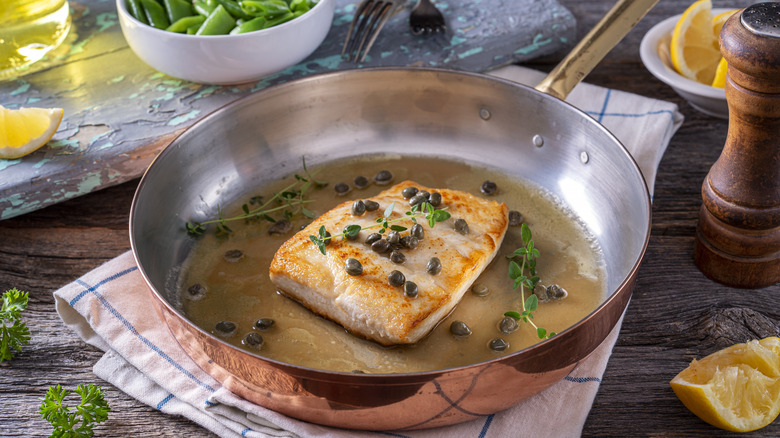The Major Mistake Most People Make When Cooking Fish
Adding fish to your diet is a sure-fire way to add omega-3 fatty acids to your routine. According to the U.S. National Oceanographic and Atmospheric Administration (NOAA), this is good for your brain, and can improve your cardiovascular and immune systems. Fish is also a great source of lean protein, which can help you build muscle and slim down. A lot of people don't cook fish because they think it's too complicated, or they've tried it in the past and things didn't come out quite right. Hands down the biggest mistake people make when cooking fish is simply touching the fish too much while it's cooking.
Cooking fish is actually pretty easy as long as you force yourself to be hands-off: Don't flip it over and over, or keep poking it. This is because most species of fish have delicate textures; if you fuss with the fish and try to move it around in the pan or on the grill too much it'll fall apart, release its juices, and dry out. To keep your fish intact, let the heat do its job. So if you want your seared mahi-mahi to cook perfectly and stay moist and flavorful, you've got to be patient.
Prep the fish properly and make sure the stove is hot
Fish is more expensive than, say, chicken breast, so it's not unusual to be a little anxious and hover over the stove. Fish needs enough time to sear, however; otherwise it'll stick to the pan or grill grates and tear when you try to slide your spatula underneath. Your job is to make sure all the conditions are right for cooking.
Prepare your pieces of fish for cooking by first patting them dry with a paper towel; this will ensure that your cooking oil makes better contact with the surface of the fish. Next, season each piece with salt and pepper.
If you're grilling fish, clean the grates and season them with oil, then brush your fish with the same oil too. Next, preheat your grill with two heat zones, one hot (at or near 500 degrees Fahrenheit) and one cool (225 to 375 degrees Fahrenheit) so that you can sear the fish and then move them to the cooler zone to cook through without burning. If you're sauteéing, get your pan hot over medium-high heat and add the oil or butter to the pan. If you want to test the pan to see if it's hot enough before placing your fish in it, test it with a drop or two of water; if it rolls around in a ball before evaporating, it's ready.
Use a proper fish spatula
Once the fish and cooking surface is ready, place your fish on the grill or in the pan and let it sear. Cook for at least two to four minutes before checking it. If the fish isn't ready to flip, the surface will stick to the pan or grill grates, but when it's ready it'll be easy to flip.
One of the best tools for turning fish is a slotted metal spatula with a very thin edge, which you can slide under delicate pieces of fish with the least amount of damage. Tongs might seem convenient, but they can poke into the fish and rip the surface. Tongs also can't provide support under the fish, so they can cause your pieces to break apart when you try to flip them.
If you think the fish might be ready for turning, poke the edge of your spatula under a piece of fish: If you meet resistance, wait another minute or two before trying again — don't force things. Even though a fish spatula slides easily between pan and fish, you'll still damage the sear and lose important juices if you exert your will over the fish. When the surface of the fish is nice and crisp, it should come away from the cooking surface easily.
If all else fails and you're still having trouble cooking your fish, it's totally okay to use nonstick pans, they're a foolproof way to perfectly cook fish.


